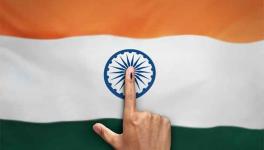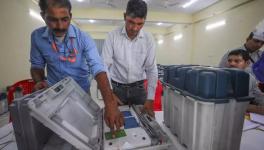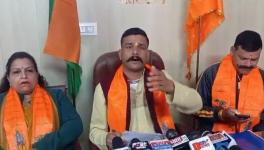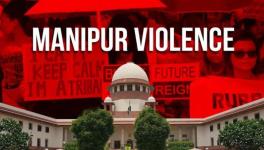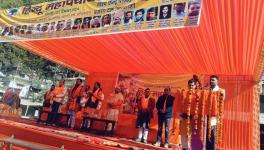Elections in 5 States to be held in 7 Phases; Yogi, Akhilesh Declare March 10 Victory
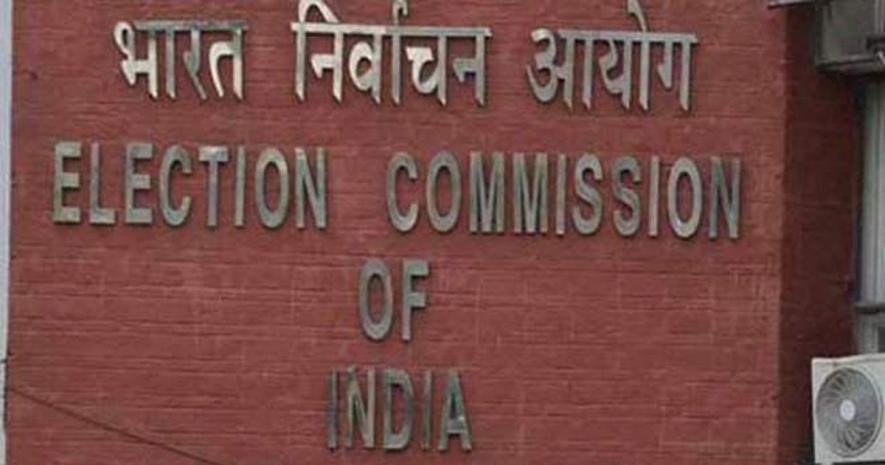
Image Courtesy: scroll.in
New Delhi: Assembly elections in Uttar Pradesh (UP), Punjab, Goa, Manipur and Uttarakhand will be held in seven phases while ensuring COVID-19 safety protocols, the Election Commission of India (ECI) announced in New Delhi on Saturday even as more than 1.41 lakh cases were recorded in the country in the last 24 hours.
The dates were announced under the shadow of the Omicron virus with the ECI acknowledging that COVID-19 has made conducting elections a “challenge” in the last two years. “For the past two years, COVID has made conducting elections difficult. We have to conduct elections in a way which saves both voters and parties,” chief election commissioner (CEC) Sushil Chandra said.
UP will go to the polls in seven phases from February 10 to March 7. Punjab, Uttarakhand and Goa will vote on February 14 while Manipur will vote on February 27 and March 3. Votes will be counted on March 10, Chandra said.
A total 690 Assembly constituencies will with the maximum in UP at 403 seats, followed by Punjab at 117, Uttarakhand 70, Manipur 60 and Goa at 40.
The first phase of polling in UP will be held on February 10. In the second phase of polling, UP will vote along with Punjab, Uttarakhand and Goa on February 14.
The third and fourth phases of polling in UP will be held on February 20 and February 23. The fifth phase in UP and the first phase in Manipur will be held on February 27.
The sixth phase of polling in UP and the second phase in Manipur will be held on March 3. The seventh phase of polling in UP will be held on March 7.
With 18.34 crore Indians set to vote, Chandra said that delaying the elections would have been “undemocratic” while announcing a slew of safety protocols and precautions.
“Our first and foremost objective is a COVID-safe election. A lot of advanced planning and meticulous preparation has been done. We have been working on election preparedness for the past six months. Keeping Omicron in view, we will take all precautions possible, the CEC said.
To ensure minimum physical interaction during nomination, campaigning and voting, the ECI has introduced online nomination for candidates, capped the number of voters per booth at 1,250 and will also provide the facility of postal ballot to infected voters.
Announcing the other safety measures, Chandra said that all polling officials will be doubly vaccinated and receive booster shots and all the booths will be sanitised.
Stressing the importance of minimum physical contact and safety guidelines, the ECI asked all the parties and their candidates to try their best to campaign online, and barred all physical roadshows, processions, cycle or bike rallies till January 15 considering the “dynamic” situation in view of the increasing cases. The ECI also banned victory processions. It physical rallies are allowed after January 15, they must be conducted according to COVID-19 protocols, Chandra added.
Except for Punjab, the other four states are ruled by the BJP. The term of the current UP Assembly will end in May while those of the other four Assemblies will end on different dates in March.
UP, where chief minister Yogi Adityanath hopes to replicate the BJP’s 2017 success despite the anti-incumbency factor, the criticism of the state government’s handling of the second COVID-19 wave last year and the challenge posed by Samajwadi Party (SP) president and former CM Akhilesh Yadav, is the most critical state for the saffron party followed by Punjab.
In the 2017 elections, the BJP had bagged 303 seats while the SP won 49 seats, the Bahujan Samaj Party 15 and the Congress a dismal 7.
Soon after the polling dates were announced, both Yogi and Yadav claimed that their parties will form the next government with a thumping majority.
Yogi tweeted in Hindi: “लोकतंत्र के महापर्व में प्रदेश के चुनाव की तिथियों की घोषणा का स्वागत। भारतीय जनता पार्टी डबल इंजन की सरकार की उपलब्धियों के आधार पर जनता जनार्दन के आशीर्वाद से प्रचंड बहुमत की सरकार बनाने में सफल होगी। (We welcome the festival of democracy. With the blessings of the people and on the basis of the double-engine government’s achievements, the BJP will form the government with an overwhelming majority.)”
Yadav, whose recent rallies have been jampacked, too tweeted in Hindi claiming that a “revolution” will take place in UP on the counting day: “10 मार्च को इंक़लाब होगा उत्तर प्रदेश में बदलाव होगा (Revolution will happen on March 10. Uttar Pradesh will change.)”
While the BJP has allied with many small caste-based state parties, like the Bharatiya Samata Samaj Party and the Bhartiya Manav Samaj Party, the SP has teamed up with the Janwadi Party (Socialist), Om Prakash Rajbhar’s SBSP, Keshav Dev Maurya’s Mahan Dal, the Krishna Patel-led Apna Dal faction and Jayant Chowdhury’s Rashtriya Lok Dal.
Both the Congress and Delhi CM Arvind Kejriwal’s Aam Aadmi Party (AAP) have decided to go solo and contest all the seats in UP.
In Punjab, the BJP has formed an alliance with former Congress member and CM Captain Amarinder Singh’s new party Punjab Lok Congress. In the 2017 elections, the Congress formed the government after winning 80 out of the 117 Assembly seats while former allies Shiromani Akali Dal and the BJP bagged 14 and 2 seats respectively and the AAP 17.
In Goa, the BJP is facing anti-incumbency and challenges from the AAP, the Trinamool Congress, the Congress, which has aligned with the saffron party’s former coalition partner Goa Forward Party (GFP). In the 2017 elections, the Congress was unable to form the government despite emerging as the single-largest party after winning 17 of 40 seats with the BJP forming a coalition with independents and regional parties, including the GFP, to reach the tally of 13 seats.
The BJP will also face the Congress and the AAP in Uttarakhand, where CMs were changed twice in less than six months. Trivendra Singh Rawat was replaced by Tirath Singh Rawat in March only to be removed in July with the party appointing Pushkar Singh Dhami in his place.
In Manipur too, the Congress was unable to form a government despite winning 28 out of 60 Assembly seats with the BJP forming a governing coalition with the National People’s Party, the Naga People’s Front and the Lok Janshakti Party. The Grand Old Party is also facing serious problems with several of its MLAs and former state party chief Govindas Konthoujam defecting to the BJP in the last five years.
Incumbent CM N Biren Singh, who had defected from the Congress to the BJP in 2016, has a tough road ahead with growing discontent against him in the state unit. A worried BJP high command had summoned Singh, state minister Biswajit Singh and Manipur BJP chief A Sharda Devi to Delhi in October.
Get the latest reports & analysis with people's perspective on Protests, movements & deep analytical videos, discussions of the current affairs in your Telegram app. Subscribe to NewsClick's Telegram channel & get Real-Time updates on stories, as they get published on our website.









